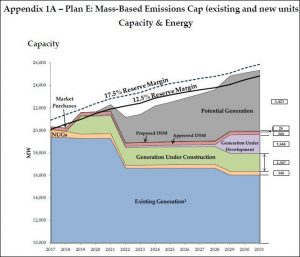
Dominion Virginia Power capacity projections under Clean Power Plan E. Source: 2016 Integrated Resource Plan (Click for more legible image.)
by James A. Bacon
A Virginia consumer advocacy group has petitioned the State Corporation Commission to forbid Dominion Virginia Power from spending more money on its proposed $19 billion North Anna 3 nuclear unit without obtaining formal approval from the SCC.
Dominion has spent $600 million on the project, mainly for engineering and regulatory expenses, but also $58.6 million on site preparation, administrative buildings, and “craft and other service support buildings,” maintains the Virginia Citizens Consumer Council (VCCC) in the SCC filing. “As Dominion spends more money on North Anna 3, it may become more difficult for the expenditures to be disallowed without causing financial harm to the utility.”
The SCC has allowed Dominion to recover $310 million of the money spent so far, but the company has stated in its Integrated Resource Plan that it will not seek cost recovery for the rest until it receives a federal Combined Operating License (COL). The COL, the company says, will provide “an option to build a nuclear unit at the North Anna site at some point in the future,”which is “of great value given the uncertainty of the [Clean Power Plan] and the uncertainty of any other federal or state law or regulation that the Company and its customers may face in the future.”
While Dominion contends that ongoing construction costs are incurred solely at the risk of the company’s stockholders, says the VCCC filing, “the Company has made it clear that at some point in the future, it intends to seek recovery of those expenditures, whether or not the project is ever completed. … The Company is treating all ongoing expenditures as ‘recoverable’ for accounting purposes.”
Consumer and environmental groups have long contended that the proposed North Anna 3 plant would be far more expensive than non-nuclear alternatives such as energy conservation, electricity purchases from wholesale markets, and green energy sources such as wind and solar, backed by energy storage technologies such as batteries. Building North Anna 3, according to the Virginia attorney general, could boost electric rates by 26% in Dominion’s service territory.
In its Integrated Resource Plan (IRP), Dominion has described a third unit at the North Anna nuclear power station as its ace in the hole should Virginia adopt the most stringent alternative available to the states under the Clean Power Plan, which limits CO2 emissions from the nation’s power plants. The so-called Plan E, or “Mass-Based Emissions Cap” applying to both old and new generating units, would force Dominion to retire some of its fossil fuel generating plants and would leave nuclear and renewables as the only viable non-CO2 emitting alternatives for replacing that capacity and meeting increasing demand as the economy grows. In Virginia, environmentalist groups are urging the McAuliffe administration to adopt the strictest Mass-based option should the Clean Power Plan pass U.S. Supreme Court muster next year.
Dominion has characterized wind and solar as intermittent, thus “nondispatchable,” meaning that they generate power when the wind blows and the sun shines, not necessarily when people are consuming electricity. The electric grid can handle a significant amount of variable production, but at some point the system becomes unstable. In a Plan E regulatory environment, Dominion argues, building nuclear would be the only way to add stable base-line capacity. In essence, Dominion regards North Anna 3 as insurance, albeit very expensive insurance, should Virginia adopt the strictest approach to controlling carbon emissions.


